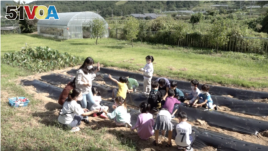14 December 2022
In the 1970s, more than 800 students filled the classrooms of Cheontae Elementary School in rural Hwasun County. The school is set among a group of small villages and rice farms in southwestern South Korea.
By 2021, the school's population had dropped to just 24 students. Without intervention, local officials said, Cheontae Elementary could soon close.
The large decrease is the result of both South Korea's falling birth rate and fast urbanization that has sent huge numbers of young people to the city for better jobs.

Students at Cheontae Elementary School learn agriculture skills, such as how to tend a garden. September 20, 2022.
The situation is the same for many schools across South Korea. Since 1982, more than 3,800 schools nationwide have shut down because of a lack of students. Most of the closures have happened in rural areas.
In Dojang, a small village about a five-minute drive from Cheontae Elementary, locals understand that their community is on the edge of extinction.
"People in their 60s and 70s are considered young here," said 82-year-old Moon Gyeongga. "There is not a single child in this village. Everyone with kids leaves for the city," Moon added.
If the community loses its school, there would be almost no hope of bringing in young families. That is why Cheontae Elementary recently began taking part in a program that brings students from the capital city of Seoul to study in the countryside.
Under the program, which started in March 2021, Seoul children study for at least six months in schools throughout the southwestern part of the country. The mostly rural area has been hit especially hard by South Korea's population crisis.
The exchange program is paid for by both Seoul and local government groups.
What it looks like
So far, Cheontae Elementary has seen hopeful results. Since it began accepting Seoul students last spring, attendance has doubled to over 50.
Along with saving the school, the increased attendance has brought practical benefits for local students. Before the exchange program, it was difficult to find enough children to play team sports, like soccer or basketball, said sixth-grader Lim Sung-ju.
"I have more hobbies now, and I can experience more things. Basically, I just have more fun," Lim said.
More students also mean the school receives more resources and employees – such as a vice principal who can work on lesson planning.
Seoul exchange students benefit, too. They are able to take a break from the overcrowded capital area. They can enjoy more outdoor activities, cleaner air, fewer crowds and a less competitive educational environment.
"It's possible to educate the whole person here," said Kim Na-yoon, a Seoul local whose son is in the third grade at Cheontae Elementary.
The exchange students also report feeling less stress away from Seoul, said Hwasun County school chief Lee Hyeong-hui. "This is good for all of Korea in the long term," she said.
Not a perfect solution
However, many locals worry the program is only a partial fix. They note it does not deal with the main problem facing rural communities: a lack of income for locals.
"The (local) population is still not growing," said Park Gong-ryeol, a 67-year-old who has lived in Hwasun County for 18 years.
Park supports the exchange program. He even helps run a housing center for exchange students and their parents. But he said the government should do more to increase the earnings of local farmers who have historically depended on small rice fields.
Without that kind of intervention, hundreds of rural communities could soon disappear. A March study by the Korea Employment Information Service says 113 of South Korea's 228 cities, counties and districts are at risk of extinction.
Bigger plans
Cho Hee-yeon leads the Seoul Metropolitan Office of Education. He is also the driving force behind the exchange program. He hopes this is just the beginning. He wants to one day attract enough students to expand the program to rural areas nationwide.
"We hope that by studying in rural areas, children will be able to escape the concrete jungle, experience living in nature, develop a second hometown, and grow in a healthier way," he said.
Cho considers the program to be part of a large plan for more balanced, sustainable development in the country.
"Korea is traditionally a rice-farming society, but unfortunately some kids these days think rice grows on trees," Cho said, laughing. "The goal is to make children remember rural areas even as adults."
I'm John Russell. And I'm Ashley Thompson.
William Gallo and Lee Juhyun reported this story for VOA News. Ashley Thompson adapted it for VOA Learning English.
______
Words in This Story
urbanization - n. the process by which towns and cities are formed and become larger as more and more people begin living and working in central areas
extinction - n. the state or situation that results when something has died out completely
benefit - n. a good or helpful result or effect
hobby - n. an activity that a person does for pleasure when not working












